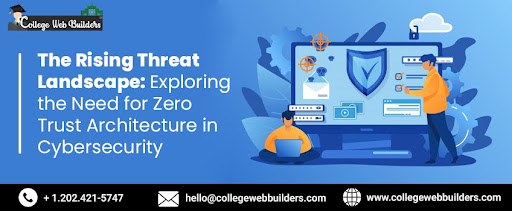
The Rising Threat Landscape: Exploring the Need for Zero Trust Architecture in Cybersecurity
In today's digital age, cybersecurity has become a critical concern for individuals and organizations alike. The increasing frequency and sophistication of cyber threats necessitate innovative approaches to protect sensitive data and systems. One such approach that has gained significant attention is the implementation of Zero Trust architecture. In this blog, our cyber security development agency Ashburn USA will delve into the evolving threat landscape and explore how Zero Trust architecture is reshaping cybersecurity.
Enter Zero Trust Architecture
Zero Trust architecture is a security framework that challenges the traditional "trust but verify" approach. It assumes that no user or device should be inherently trusted, even if they are within the network perimeter. Instead, Zero Trust adopts a "never trust, always verify" principle, treating every access attempt as potentially malicious until proven otherwise.
At its core, Zero Trust architecture focuses on granular access control and continuous authentication. Rather than granting broad access privileges, users are assigned the least privileges necessary to perform their tasks. Additionally, multifactor authentication and continuous monitoring ensure that user identities and behaviors are constantly evaluated and verified.
Benefits of Zero Trust Architecture
Implementing Zero Trust Architecture (ZTA) in cyber security development brings several significant benefits to organizations, enhancing their cybersecurity posture and mitigating the risk of data breaches. Let's explore some key advantages of Zero Trust:
1) Improved Security: Zero Trust replaces the traditional perimeter-based security model with a more robust and dynamic approach. By eliminating the inherent trust traditionally placed on devices and users, Zero Trust ensures that every access request is verified and validated, significantly reducing the attack surface. This approach helps prevent unauthorized access and lateral movement within the network, making it harder for cybercriminals to exploit vulnerabilities.
2) Enhanced Data Protection: Zero Trust focuses on securing data at its core. By adopting granular access control policies and classifying data sensitivity, organizations can enforce least privilege access, ensuring that users only have access to the data they need for their specific roles and responsibilities. In the event of a security breach, Zero Trust limits the potential damage by containing the breach within segmented zones, preventing the lateral spread of the attack.
3) Adaptive and Contextual Access: Zero Trust incorporates contextual factors such as user identity, device posture, location, and behavior to determine access privileges dynamically. This adaptive approach enables organizations to grant access based on real-time risk assessments. For example, if a user's behavior or device posture raises suspicion, the system can prompt for additional authentication measures or restrict access until the security concern is addressed. This ensures that access privileges align with the current security context.
4) Better Detection and Response: Zero Trust emphasizes continuous monitoring and real-time threat detection. By leveraging advanced security tools and analytics platforms, organizations can identify anomalies, unusual behaviors, and potential threats more effectively. This proactive approach allows for rapid incident response, reducing the time it takes to detect and remediate security incidents. The continuous monitoring also enables organizations to gain insights into their network and user activity, improving their ability to identify patterns and potential vulnerabilities.
5) Simplified Compliance: Zero Trust aligns with several compliance frameworks, making it easier for organizations to meet regulatory requirements. By implementing robust access controls, encryption measures, and continuous monitoring, organizations can demonstrate a strong security posture, aiding in compliance audits and reducing the risk of non-compliance penalties.
6) Scalability and Future-Readiness: Zero Trust can scale with the growth and evolving needs of organizations. As new devices, applications, and services are introduced, Zero Trust principles can be extended to ensure consistent security across the expanding network. This future-readiness allows organizations to adapt to changing business requirements and emerging cybersecurity threats.
Implementation Considerations
As organizations embrace the concept of Zero Trust Architecture (ZTA) in cyber security development services, several key implementation considerations must be taken into account. Transitioning to a Zero Trust model requires careful planning, collaboration, and a holistic approach to ensure its effectiveness. In this section, our cyber security development agency has noted some essential considerations for implementing Zero Trust Architecture.
1) Comprehensive Network Assessment: Before implementing Zero Trust, organizations must conduct a thorough assessment of their existing network infrastructure. This includes identifying all assets, devices, and endpoints connected to the network, as well as evaluating their security posture. This assessment will help in understanding the network's vulnerabilities, potential attack vectors, and areas that require additional security measures.
2) Mapping Trust Boundaries: Zero Trust challenges the traditional perimeter-based security model and assumes that no device or user can be inherently trusted. It is crucial to define trust boundaries based on granular policies and user roles. This involves identifying critical assets, classifying data sensitivity, and establishing access control mechanisms accordingly. By mapping trust boundaries, organizations can enforce least privilege access and restrict user permissions to only what is necessary for their role.
3) Strong Identity and Access Management (IAM): Zero Trust heavily relies on robust Identity and Access Management practices. Implementing multi-factor authentication (MFA) across all systems and applications is essential to ensure that only authorized individuals can access sensitive data or systems. Organizations should also adopt strong password policies, enforce regular password rotations, and implement privileged access management solutions to mitigate the risk of credential-based attacks.
4) Segmentation and Microsegmentation: Network segmentation is a critical component of Zero Trust implementation. It involves dividing the network into isolated segments or zones, creating multiple security perimeters. Microsegmentation takes this concept further by segmenting the network at a granular level, allowing for specific security policies to be applied to individual workloads or applications. This helps contain lateral movement and limits the potential impact of a security breach.
5) Continuous Monitoring and Analytics: Implementing a Zero Trust model requires continuous monitoring and analysis of network traffic, user behavior, and system logs. Organizations should leverage advanced security information and event management (SIEM) tools, intrusion detection and prevention systems, and behavior analytics platforms to detect anomalies and potential threats in real-time. This proactive approach allows for prompt incident response and reduces the time-to-detection and time-to-remediation.
6) User Education and Awareness: While technology forms the backbone of Zero Trust, user education and awareness play a vital role in its successful implementation. Employees should be trained on the principles of Zero Trust, the importance of following security protocols, and recognizing potential social engineering or phishing attacks. Regular cybersecurity awareness campaigns and simulated phishing exercises can significantly contribute to a security-conscious culture within the organization.
7) Scalability and Flexibility: Zero Trust implementation should be scalable and adaptable to the organization's evolving needs. As the IT landscape changes, new devices, applications, and services will be introduced, and security policies must be easily extendable. It is crucial to choose scalable solutions and technologies that can seamlessly integrate with existing infrastructure, ensuring future-proofing and agility.
Conclusion
As the threat landscape continues to evolve, organizations must adapt their cybersecurity strategies to effectively mitigate risks. Zero Trust architecture offers a proactive and robust approach that challenges the traditional trust-based model. By adopting a "never trust, always verify" mindset, organizations can better protect their assets, minimize the impact of cyber attacks, and ensure a secure digital environment for their users. For more information, visit Collegewebbuilders.com .
- Tags: Marketing, Onlline, Internet





